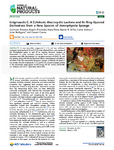Enigmazole C: A Cytotoxic Macrocyclic Lactone and Its Ring-Opened Derivatives from a New Species of Homophymia Sponge

View/
Use this link to cite
http://hdl.handle.net/2183/31043Collections
- Investigación (FCIE) [1228]
Metadata
Show full item recordTitle
Enigmazole C: A Cytotoxic Macrocyclic Lactone and Its Ring-Opened Derivatives from a New Species of Homophymia SpongeAuthor(s)
Date
2022-03-02Citation
Tarazona, G.; Fernández, R.; Pérez, M.; Millán, R. E.; Jiménez, C.; Rodríguez, J.; Cuevas, C. Enigmazole C: A Cytotoxic Macrocyclic Lactone and Its Ring-Opened Derivatives from a New Species of Homophymia Sponge. J. Nat. Prod. 2022, 85 (4), 1059–1066. https://doi.org/10.1021/acs.jnatprod.1c01179
Abstract
[Abstract] A new macrolide, enigmazole C (1), and two additional analogues, enigmazoles E (2) and D (3), were obtained from a new species of the Homophymia genus as part of an ongoing discovery program at PharmaMar to study cytotoxic substances from marine sources. The structures were fully characterized by cumulative analyses of NMR, IR, and MS spectra, along with density functional theory computational calculations. All three of the new compounds feature an unusual 2,3-dihydro-4H-pyran-4-one moiety, but only enigmazoles C (1) and D (3) showed cytotoxic activity in the micromolar range against A-549 (lung), HT-29 (colon), MDA-MB-231 (breast), and PSN-1 (pancreas) tumor cells.
Editor version
Rights
Atribución 4.0 Internacional
ISSN
0163-3864
1520-6025
1520-6025






